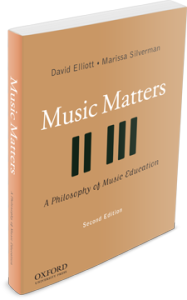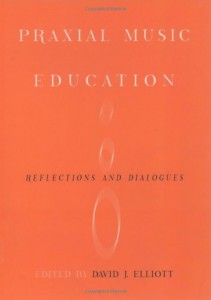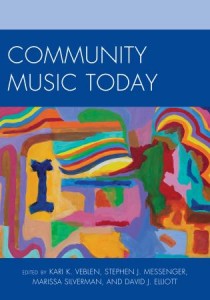Is the human mind a product of nature, or nurture; is it genetic, or social? My answer is: both! The human mind results from (a) physical processes in the brain that depend on genetic endowments, and (b) social-cultural influences (memes) that interact with individual brains. I argue (a) that “the body is in the mind” in the sense that it’s impossible to have a human mind without a physical brain and its processes (thinking, feeling, remembering, and so on). On the other hand, I argue (b) that the mind is not limited to brain processes alone, as I note in this passage:
As Dennett suggests, memes are what turn brains into minds. Memes cohere and replicate in the brains of humans by being taught, learned and passed around via languages, schools, books, artifacts, performances, tools and so on. Human beings grasp, generate and modify memes. But if this is so, then human consciousness is not isolated. Consciousness is of the world. It is situated, or context-dependent: it develops and functions in relation to its social-cultural location. (MM, p. 111)
Szego acknowledges my integrated perspective when she notes that “Elliott calls on more contemporary theories to demonstrate the ways in which mind and body are connected” (PME, p. 201).
In MM, I deliberately began my discussion of the mind-body relationship in relation to musical performing (MM, chapter 4) to emphasize from the outset that when a music maker is making music, his/her actions are holistic: mental-and-physical together (to use old, dualistic language. (The same applies to the music listener, as I explain in MM, chapter 3). My motivation for doing this was partly for the purpose of driving home the point that the actions of a performer, improviser, or dancer (and so forth) are not “dumb” because they are not verbal.
From these foundations, I argued that “if the body is in the mind, then it makes perfect sense (as Dalcroze, Orff, and Kodaly specialists maintain) that the kinds of moving involved in music making are essential to improving musical understanding” (MM, p. 103). However, I did not emphasize an important additional point that Westerlund and Juntunen bring to our attention, namely this:
Movement involved in music making also increases so-called bodily knowledge. “Bodily knowledge” refers to improved knowing in and through the body, which, in turn, has a direct connection to senses and bodily awareness, as well as to abilities, skills, and action. (PME, p. 119)
As Westerlund and Juntunen add: “The bodily experience of music opens the doors of hearing, feeling, understanding,” remembering, and so forth (p. 119).
So, I agree with Westerlund and Juntunen on these important points. I should have said more about the relationships among different kinds of moving, and dancing, in music education, and I should have discussed the practical implications of moving and dancing in music education. However, I will correct myself on these issues in the future.
I also agree with Westerlund and Juntunen when they say that “a human organism is a functional whole; the mind and body are inseparable, though different aspects of this singleness” (p. 112). However, I disagree with on several other points. I believe our disagreements stem partly from the complexity of this topic and partly from their omission of several points I make in MM. Let me begin with some fundamental issues that my critics may not have considered.
The vast majority of neuroscientists and philosophers of mind today agree that “the mind arises from the activity of the brain” (Marcus, 2004, p. 1). As MIT scientist Steven Pinker (1997) says, “the mind is what the brain does” (p. 216). Genes are the basic building blocks of human brains. Genes hold the keys to the processes we call attention, cognition, emotion, and memory, which in turn permit us to think, feel, see, hear, move, and so forth. Moreover, there is no special mental or genetic “stuff” in our brains. “Genes play almost exactly the same role in building the brain as they do in building any other part of the body” (Marcus, 2004, p. 13). Most importantly, it’s important to keep in mind that the processes we call thinking, feeling, remembering (and so on) are physical-chemical processes that are carried out by our brain constructs (e.g., neurotransmitters, dendrites, synapses, neurons). (Moreover, different parts of the brain are more active during different activities, depending on our personal histories).
Evidence of the brain’s influence on the mind is everywhere: if a person drinks too much alcohol, his senses, emotions, and abilities will be impaired; if a person suffers a stroke, she will lose many abilities and memories: if a child with ADHD takes a particular drug, s/he may be helped or harmed. In short, our brains and brain processes are just as bodily-corporeal as our toes and fingers. Without brains, we would not be able to see, hear, talk, or move (or do anything else) – we would be “brain dead.”
The next two points address issues I emphasize early in MM. First, I define “cognition” in MM as “knowing in the widest sense of the term. Cognition includes all processes involved in the verbal and nonverbal organization, retrieval, use and application of our apprehensions. Cognition refers to the various processes by which we recognize, relate and deploy ‘information’ from inside and outside ourselves” (p. 52). My definition of “information” is “all the differentiated sights and sounds, all the recognized thoughts and emotions, all the situations and events, and so on, that we encounter [italics added]” (MM, p. 52). Finally, I insist that “attention, awareness, and memory interact. Our everyday phenomenological experience results from the integration of our powers of consciousness. There is likely no such thing as cognition without emotion, emotion without cognition, awareness without attention, and so on [italics added]” (MM, p. 52). My critics overlook the interactive and integrated concept of brain-mind I posit. As Gruhn says: “a praxial approach to developing musical understanding integrates so-called mental and practical skills; it brings together doing, making, feeling, and thinking; and it complements action and reflection” (PME, p. 106).
Likewise, in my view, pleasure and enjoyment are not at odds (as Westerlund and Juntunen state); rather, they are on the same continuum.
Next, I believe my colleagues’ concept of the body-brain-mind relationship is murky. They seem to think we can listen, sense, and feel without a brain. They believe that the body is “an instrument through which musical thinking takes place” (PME, p. 113). But what do they mean by “the body”? And where does such bodily “thinking” occur – in the toes, or the ankles? Surely musical thinking requires our bodily brain? Please note that I am not saying that we merely “intellectualize” music when we hear it. Not at all. I’m only saying that the brain-mind (genes and memes) must be involved together in processing auditory patterns (cognitively and affectively) in order for people to move to musical patterns. In short, I think it’s misleading for Westerlund and Juntunen to argue that “the body is not only an instrument through which musical thinking takes place; the body can be taken as a conscious and explicit object of transformation” (PME, p. 113). If by body they mean brain-mind, I agree. If they mean “body” as in arms and legs alone, I disagree for the reasons I’ve offered above.
Furthermore, I do not agree with their criticism that I view the mind as “nothing but the physical brain.” Clearly, I do not “reduce the body and mind to the material brain,” and I never say the brain is an isolated system, as my critics argue (PME, p. 116).
Now the central criticism argued by Westerlund and Juntunen is that “instead of embodied mind and knowledge, Elliott seems to have a theory for embrained knowledge” (PME, p. 116). I disagree with this claim, too, for the reasons I’ve given above and for the explanations given in MM: the human-mind (consciousness) combines many complex physical and social dimensions in the process of listening to and making music. Perhaps a more complete reading of MM regarding these issues would alleviate my critics’ concerns?
Their next criticism states that my view of listening is one in which people use their brains (alone) to simply “scan acoustic waves for musical information” (PME, p. 116). This claim is based on only a few words (“scan acoustic waves”) from the first section of my very long explanation of the nature of music listening and musical works (which extends over several chapters). In fact, I offer a multilayered explanation of music listening that examines the many ways our brain processes and cultural understandings make music listening possible. My critics take no notice of these discussions in their essay.
Their final concern is that I should have accounted for more than the enjoyment and pleasure of making and listening to music. My reply is that I do explain many other values of music, including the ones Westerlund and Juntunen discuss (see, for example, MM, chapter 12; and this web site: Values and Affect; Music and Identity) However, I understand that they want me to include the values of “bodily knowledge.” On one hand, I agree. On the other hand, I wonder whether the concept of “bodily knowledge” creates another kind of dualism and/or rests on shaky ground (due to its apparent lack of concern for the physical brain that facilitates the mind). I also wonder how this concept seems to contradict Westerlund and Juntunen’s commitment to mind-body holism?



